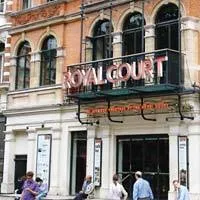Sets and the City: 'Wig Out' and The Royal Court Theatre
Written by

By James Hadley in London
After five months of being in London, this week I finally found my way to the Royal Court Theatre in Sloane Square - the highest profile London home of new writing for the theatre. Its status as a site of pilgrimage for theatre lovers is based on being the venue where many of the key UK playwrights of the second half of the twentieth century came to prominence.By James Hadley in London
After five months of being in London, this week I finally found my way to the Royal Court Theatre in Sloane Square - the highest profile London home of new writing for the theatre. Its status as a site of pilgrimage for theatre lovers is based on being the venue where many of the key UK playwrights of the second half of the twentieth century came to prominence.John Osbourne's 'Look Back in Anger' famously premiered here, and also Caryl Churchill's 'Top Girls', Mark Ravenhill's 'Shopping and F**king' and Sarah Kane's 'Blasted'. But there's no sense of it's profile being based on its heritage status - this is a theatre that prides itself on its engagement with the newest writers who are most attuned to the key issues of our times. Oh, and it also has one of the best theatre bars in London.
My first visit was to see the UK premiere production of 'Wig Out' by African American playwright Tarell Alvin McCraney. McCraney's such a hot property that he has had three of his scripts produced in major London venues this year - not bad for a writer who just graduated from university last year! The other two were both at The Young Vic - 'The Brothers Size', which transplants a Yoruba myth to Louisiana, and 'In the Red and Brown Water', the second play in the same trilogy. He's won the Cole Porter playwriting award and he's still only 19 years old. You can read an interview with him at this link.
'Wig Out' is staged in the main auditorium at the Royal Court (there's also a smaller auditorium - 'Upstairs at the Royal Court'), which is usually an end-stage, contemporary version of a proscenium arch venue. For this show, it's been reconfigured so the play happens on a raised catwalk which thrusts out into the auditorium. I'm guessing this play is something of a departure for the playwright.
It follows the fortunes of the 'House of Light' - described in the show's flyer as 'a hyper-glamorous, uber-competitive drag queen refuge where a daughter who was once a son can find a family.' Maximum theatricality is allowed by the play following the fortunes of the drag queens when competing with a rival House at a Cinderella Ball. To a selection of house and hip hop tracks, drag queens try to outperform their rivals. The Fates, three female singer/dancers who are daughters of the House of Light also perform a few numbers with maximum attitude and flirtation. To audience members who had never been in a gay nightclub or seen drag performance, I imagine it would have all been quite an eye-opener.
The Royal Court has a tradition of publishing the scripts it presents as programmes for the show. This is great for getting the script into circulation, plus it's priced at an affordable £3. In his foreword, McCraney writes about wanting to explore how minority and outsider groups band together to try and gain some sense of belonging and solidarity, but often do so in a format which replicates the oppressive hierarchies of wider society. As he acknowledges, what's most challenging about 'Wig Out' is not the competitive and hierarchical culture of these reconstituted families, but the portrayal of a spectrum of queer sexualities by a cast of African American characters. Ideas around gender are turned on their head by the first scene of the play, where a drag queen picks up a straight-acting, hoodie-wearing man, taking off her wig to take the dominant sexual role in bed. When popular culture's dominant identities of African American men are hard talking, hyper-macho hip hop artists with lots of bling and scantily clothed women, this is a decidedly different representation, and explores characters' comfort levels in relation to dominant perceptions of how a man should act.
Read previous Sets and the City blogs
Feel free to get in touch with any questions (or if you're planning a London visit and want some theatre recommendations) to jamesstuarthadley@gmail.com
Use the comment box below
15/12/08